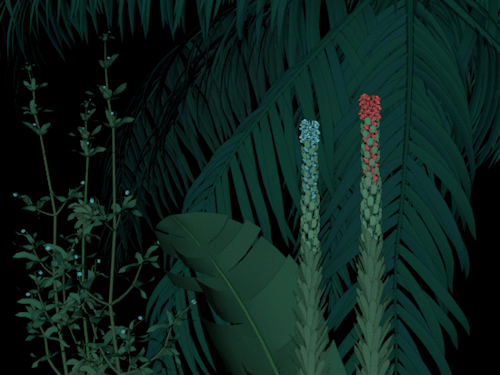
By Patricia de Vries
I meant to write about death, only life came breaking in as usual
_Virginia Woolf
It all started with a Beagle dog falling into a pit of crap. As it often does, incidentally. It was a warm summer day somewhere in the early 1980s in a forest in British Columbia. – Cut.
Jump cut to Western Europe, where in that same timeframe the rhizome first appeared on the Continental Philosophy stage. “We’re tired of trees. We should stop believing in trees, roots and radicles,” Deleuze and Guattari write in A Thousand Plateaus. “They made us suffer too much.” Here, the tree symbolizes aborescent knowledge, structured by hierarchies and a binary logic of dichotomies; the branching, separating and division of subject and object, nature and culture, human and machine — and the horrors of the Holocaust, colonialism, and capitalism. The ordered, dualist, static tree-system finds its counterpart in the rhizome. Instead of dividing, branching and separating, the rhizome connects a multiplicity of objects, places and people. Unlike the oppositional tree structure, the rhizome is a relational, polymorphous, open and heterogeneous network.
A desecration of modernist tradition, the death of humanism, an overhaul of logocentrism, a conceptual toolbox, an artistic experiment, a new philosophy of the subject, a meme, the bandying about of words, marketing lingo, a brand, an industry, a fad, a new -ism, horse pucky, Gospel: Deleuze’s and Guattari’s rhizome project has been labeled many things. Deleuze and Guattari describe how the rhizome,
“assumes very diverse forms, from ramified surface extension in all directions to connection into bulbs and tubers. […] Any point of a rhizome can be connected to anything other, and must be. […] It ceaselessly establishes connections between semiotic chains, organizations of power and circumstances relative to the arts, sciences and social struggles.”
We are immanent to the structures we try to overturn, Deleuze and Guattari contend. The task is to rethink and overturn these structures and to intervene in the status quo from the inside. Who says this is Real Talk and that idle talk? Who says this is spirituality and that Philosophy? The rhizome “actualizes the virtual” — it scratches off veneer and maps out areas that have not been explored yet. A rhizomatic methodology makes visible what is often imperceptible, what is under the radar — or beneath your feet.
Like baroque forms, rhizomes “live with passionate intensity a life that is entirely their own. They break apart even as they grow; they tend to invade the space in every direction, to perforate it, to become as one with all its possibilities,” Deleuze writes in The Fold. “The multiple must be made, not by always adding a higher dimension, but rather in the simplest of ways, by a dint of sobriety, with the number of dimensions one already has available —always n-1 (the only way the one belongs to the multiple: always subtracted). Subtract the unique from the multiplicity to be constituted; write at n-1 dimensions. A system of this kind could be called a rhizome,” Deleuze explains.
Rhizomatic Hangover
By the nineteen-nineties, the rhizome became a party drug among new media theorists. It is easy to conceive why it pervaded cyber culture: a language of infinite possibilities, of boundless connections, of change, affective energies, the possibility of the inhabitation of a different world. “The organism is defined by its ability to fold its own parts, and to unfold them,” Deleuze suggests.
Hangovers, as everyone knows, come after the party. “We’re tired of rhizomes,” Alexander Galloway and Eugene Thacker complain in The Exploit (2007). “The promises of rhizomatic media have not been fulfilled. The world is not operating through networks of difference as Deleuze argued,” Galloway, a self-proclaimed “recovering Deleuzian,” explained at a conference in Stockholm. “Let’s have the trees back!” Far from being nonlinear, parallel, open and heterogeneous, “it’s a monochromatic culture we’re looking at today — very few dreams became a reality.” We need other concepts and new methodologies to engage with today’s societies of control, Galloway argues.
In “Postscript on the Societies of Control” Deleuze argues, in 1992, new forces are knocking at the door. These forces are the “societies of control,” in which “individuals have become ‘dividuals,’ and masses, samples, data, markets, or ‘banks.’ […] The old monetary mole is the animal of the spaces of enclosure, but the serpent is that of the societies of control.” We are living under the coils of the serpent, Deleuze argues, a predatory animal crawls through the fine cracks and fissures, spreading its deadly poison. “There’s no need for fear or hope,” Deleuze writes, “only to look for new weapons.”
I’m tired of control societies. I’m tired of monochromatism. I’m tired of surface-web centrism. I’m tired of reifications. I’m tired of panopticons. I’m tired of distributed network centrism. I’m tired of the Monumentalization of technology. I’m tired of Orwell. I’m tired of privacy fetishism. I’m tired of Romantic weepers. I’m tired of nostalgia. I’m tired of neoliberal determinism. I’m tired of dividuals. I’m tired of pro-depressives. I’m tired of surveillance porn. I’m tired of Silicon-Valley fatalism. I’m tired of the Target-coupon story. I’m tired of Either/Or-anxiety. I’m tired of men proclaiming change can only happen in the polis. I’m tired of ‘everything-is’ philosophies. I’m tired of information rationalists. I’m tired of numeric rationalists. I’m tired of Carnap. I’m tired of cartoon visions in which opportunist soulless pieces of shit in Silicon Valley take away the Cyber World from the Good Humanist, break it and then fling it into the abyss.
Not everything is a rhizome. Many things operate as trees. Perhaps, rhizomes should not be considered as the Model, as the prototype or telos of our beloved media of preference. Maybe they are not meant to be your colorful psychedelic dream-come-true. N -1 is a methodological principle or, and more to the point, an attitude heavily against inductive reasoning, against generalizations of abstractions (n+1). Sameness might seem comfortable, and feel familiar, but it’s a woolly and ill-defined concept. N-1 calls for an open mind, an imaginative mind willing to find, or rather, to create something different in the repetition of the same, to make the rhizomatic, to seek it out, as a form of affirmative politics.
If you take the society of control to be the sum total of The Frightful Five – Apple, Amazon, Google, Facebook, Microsoft – plus your local NSA, plus the four companies that run the fibre cable infrastructure on the ocean floor, you live in a society build on the assumption that life can be calculated and quantified. A society, as Seb Franklin noted, that emanates from a computational logic. A society, some are eager to believe, that simulates cognition with computation. It assumes social life – and ourselves – is knowable, calculable and can be navigated and primped. It supposes we spend every countdown-second of the fleeting time we have before death becomes us on the lines of the Tech Giants – Heaven forbid! The society of control prides itself on having ousted God of its cloud, and deems itself secular, but worships its latest technical incarnation and fears its wrath: the Algorithm.
We’re not the sum of algorithmically collected personal digital data. Not because we’re so endlessly unique, special, autonomous, complex and amazing, but, for one, because we have never been able to solve the induction problem, possibly because of our mediocrity. Not every hypothesis can be calculated; life refuses to be completely informationalized, no matter how loud neo-positivists sing praise to Big Data. Plus, every byte of data has someone’s greasy chicken-salad-sandwich fingers on it. As Ian Bogost explains, data is “distributed amongst so many different systems, actors, and processes [a confluence physical, virtual, computational, and non-computational stuffs],” that calling it ‘data’ is a huge misnomer. Computation aside: we have yet to properly explain the underpinnings for the preferences we have and the choices we make; according to scientists, we lack a theory that accounts for our motives that is able to hold (even a drop of) water, Tom Vanderbilt argues in You May Also Like: Taste in An Age of Endless Choice. We are complete strangers to the choices we make, Vanderbilt claims. Preferences, it seems, are “maddeningly elusive.” We are dog paddling in an abundance of grey matter.
I Dare You To Do One Better, Human.
Apparently, as some scholars do, you can earn an upper middle class income by shouting “Totalitarianism!” and declaring things dead and lost to Silicon Valley. At the end of the day you get to go home to your cozy abode, kick off your shoes, to continue to lament over how it is all going to pot, over a glass of chilled Sancerre. In the meantime, a group of botanists is revolutionizing the way we think about trees, intelligence and organized networks. A forest, it has become understood, is not just collection of individual trees. Researchers of the laboratory of Professor of Forestry Suzanne Simard at the University of British Columbia recently found that beneath the soil of the forest, certain kinds of common fungi exist in close relationship with trees. Below the ground, tree roots and fungi combine to form what is called a mycorrhiza, a word pair consisting of the Greek words for fungus (mykós) and root (riza). Simard explains in a TED talk that the mushrooms we see in the woods are the tip of the iceberg. Tube-like threads grow out of their stems; these filaments of fungi grow in and around plant roots. They suspended between the tapering tree roots creating a subtle, intricate network. The relationship between these mycorrhizal fungi and the trees is mutualistic, benefitting both organisms. Science writer Jennifer Fraser, writes in the Scientific American that forest trees and their root fungi share resources in an exchange for basic care. They exchange carbon for minerals. Fungi labor for the tree, and in return the tree delivers 20 – 80% of its carbon to fungi, crucial food the fungus needs to build its body as it cannot photosynthesize and cannot ingest CO2, Fraser explains. The tree, in turn, needs minerals to be able stand up straight and grow. Without minerals the average tree would be knee-high and as limp as a noodle. Fraser describes how fungi obtain those minerals by worming their tubes deep through the soil, deeper than the tips of any tree root could ever go, mining and drilling through all kinds of mineral-rich soil particles. They drill through pebbles, rob springtails of their minerals—indeed, looting is not the sole privilege of the human species—and drink the nitrogen out of a fish carcass, the leftovers of a bear’s meal. So indirectly, trees eat fish, sort of.
This network of infinite and intertwined fungi threads and tree roots connecting trees is called the Wood Wide Web, a mycorrhizal network “of many colors and shapes,” Simard says. “There can be hundreds of kilometers of mycorrhizal fungi under a single footstep.” The web they form is wood-wide, and so dense it makes it hard to view any tree as an individual, Fraser argues. The forest seems to operate as a single organism, Simard says. A tree, then, is several. The Wood Wide Web, Fraser continues, allows trees of different species to communicate with and support one another. Mycorrhizal fungi connect not just the same species of trees, but they also act as conduits between different species of trees, like birch and fir trees, much to the amazement of Fraser. Trees and their root fungi not only share food with their neighbors of different species, but in case of attack also send other trees warnings and stress signals that helps the neighboring trees to prepare for a similar onslaught, Fraser explains. Merlin Sheldrake, an expert in mycorrhizal fungi, adds, “a plant under attack from aphids [plant lice] can indicate to a nearby plant that it should raise its defensive response before the aphids reach it.” Simard clarifies, trees cry out “in a chemical way.” When a tree is under attack by a leaf-eater, say caterpillars or budworms, it produces chemicals that make its leaves taste repellingly disgusting. These chemicals are moved through the fungi web to warn other trees that there’s an intruder in their midst. —Flesh sure is tender.
The biggest and oldest trees are the busiest trees, the so-called “nodes” or “hub-trees,” Simard says. These “nodes” sprout lines in all directions and can be connected to hundreds of other trees — and everything that lives off it, on it, in it, under it and between it. Mycorrhizal fungi, Simard notes, increase the resilience of the entire forest. Botanists had no idea about the existence of this “incredible, communicative network,” Simard explains, because “we didn’t know how to look.”
What is even more impressive: new kids on the block of a different tree species, in a shaded understory, are supported with extra resources by its bigger, older and stronger neighbours, Fraser writes. But what really boggles the botanist’s mind is this: battered and dying trees dump their excess carbon in the Wood Wide Web, which then very often ends up feeding newcomers in the forest, sent along the network to new seedlings, ones that are more resilient and have better chances of surviving global warming, Simard explains. She does not yet understand “who runs the show:” if the trees or the fungus decide who gets what, but “it’s as if individual trees are somehow thinking ahead to the needs of the whole forest.” Jaw-dropping.
This dazzlingly collaborative, future-bound, underground structure that is the Wood Wide Web is challenging us to rethink the partial understanding we had of trees, for one. But there’s more. It challenges us to reassess how the metaphors and models we use to navigate the world play out in knowledge, and blind us. It challenges us to review the limits of empirical observation, and to reevaluate our relationship to beings without nervous systems – and to tree-huggers. The implications of the Wood Wide Web also raise big questions about the vitality and self-organization of matter; the possibility of kinship and collaboration with multiple others in an infinite network of connections, and the notion of common ground. And last but certainly not least it questions the adage that Man is – by its own reckoning – the Overlord of Knowledge. In The Posthuman Rosi Braidotti writes: “the centrality of the Human, that is of the Man, that is a masculine, white, urbanized, speaking a standard language, heterosexually inscribed in a reproductive unit and a full citizen of recognized polity, is now challenged…”
–By fungus! Fungus gut-punched Anthropos.
May you purr in glee, Darwin.
Are you tired of rhizomes and trees? Bring in the forest!
After decades of painstaking research, Simard and her team of international fellow botanists were able to draw the first outlines of this multilayered and multi-dimensional network. The network is so fine, layered, and intricate that scientist have only caught a glimpse of the web – not to mention its possible connection to other networks. And yet it was right there all along, burgeoning under their feet.
In The Limits of Critique Rita Felski argues that instead of “digging down” or “standing back” we should trace the “interconnections, attachments, and conflicts among actors and mediators.” Standing back you stare at the tree, its towering trunk, its branches and leaves, by digging down you see its root-system, but then the mycorrhizal fungi lay in ruins. You can’t see the forest for the trees. You must begin in the middle. “Soil is fantastically difficult stuff to work with experimentally, and the hyphae are on the whole too thin to see,” Sheldrake explains. Even laser-scans are too crude for the little, translucent and delicate tubes of the fungus, Sheldrake says.
Research on the wood-wide web, it could be argued, is more an act of creation, than of discovery. Like any creative activity, it entails a process inquiring imagination, inspiration, revelation, and plain old labor. “To live, to live well, to live better” we need to work collaboratively, harness group power, and, well, work, work work, work, work, work, work, work, work, work, work, diligently and persistently, for the benefit of all. An exhausting job, often from the margins, against the mainstream, and more often than not without the desired outcome – projects fail, people clash, and tides turn. It requires an open view to allow serendipity to sneak in.
Sheldrake explains that for each scientific paper he published, he plans to write a “dark twin” in which he describes “the messy network of crazy things that underlies every piece of cool, clean science, but that you aren’t usually allowed to see—the fortunate accidents of field work, the tangential serendipitous observation that sets off a thought train, the boredom, the chance encounters.”
Cutaway to a warm summer day in a forest in British Columbia, some 30 years ago: Simard says she first saw a glimpse of the subterranean infrastructure during a rather awkward incident with her dog Jiggs. Out on a walk in the forest with her family, the dog suddenly scampered off deep into the woods. She and her aunts, uncles, nieces, nephews followed the sound of his barking and yelping, which lead them to an outhouse. There, they found Jiggs, who had fallen two meters down and was stuck at the bottom of the outhouse pit. While the whole family was busy digging him out of out of his predicament, Simard suddenly noticed they were standing on a thick tangled carpet of intertwining and exposed tree roots. This, she explains, was the day she began to explore the underground ecology burring beneath the soil.
Affirmation is transformation. Thirty years of collaborative research later, often hard, thankless, frustrating, and repetitive work, peeling one layer off another from the surface, countless experiments on microscopic spore examinations, meticulous tests of the short-sequence of the DNA of hundreds of root samples in a series of countless plots, years of moving backward and forwards, the botanists at Simard’s Forestry lab learned where, or rather, how to look. They now start to unfold and untangle what has remained invisible: the forest in-between the forest.
Much more than a bunch of trees, the forest is a territory, a rhizomatic network, a multidimensional multiplicity, connecting all kinds of creatures cooperating together benefitting the forest as a whole – from the molar to the molecular. Exceedingly tiny little fungi-tubes saw away at the branch we’re sitting on, rupturing our fuzzy notions of trees, roots, fungus, and the forest, but also of empiricism, humankind and organized networks. Let’s bring in the forest: an adaptable, compossible space of intricate, intertwined, co-existing and co-laborative rhizomatic forces, providing ideas to resist and fight off predatory snakes, plant lice, parasites, and other ‘flavor of the month’ toxin agents that may lay ahead.
It started with an object of love up to its eyeballs in excrement — but the story didn’t end there.





